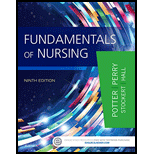
Concept explainers
To determine:
Discuss the various stressors that required to be considered when evaluating the person (S) and (J) situation.
Concept introduction:
The nurse meets the person (S) and (J) during their second visit to the Cancer Center and noticed that the person (S) is well groomed. The person (S) is not disheveled as she was during the last visit. Both the people are able to down and talk to one another about the various treatment options. Because both are here today to finalize their decision. Although (S) appears calm today (J) is worried about her emotional status and impact caring for him during treatments will have. Discuss the various stressors that need to be considered when evaluating their situation.
Explanation of Solution
The patient who is recovering from the stress feels better and reports to the nurse good when the stressors are completely gone. In the given case, both the person is coming to finalize their treatment options. In this situation, the patient should be evaluated for the presence of recurring or new stress-related symptoms. During the evaluation, the nurse should include the perception of the patient.
During the evaluation of the patient, the nurse should ask the following:
- 1. The nurse asks the patient about the ability to concentrate, appetite and sleep pattern.
- 2. Feelings about coping strategies which is being used and determining their effectiveness.
- 3. The most important is comparing the present feelings with behavior that occurs 6 months ago and the person reports good only if the desired outcome has been met 6 months ago.
In the given case, the person (S) appears nervousness because of feeling good but (J) is worried about her emotional status. In this situation, the nurse should ask the expectation of the patient that is being met and also determine the changes in the care promotion for the adaptation to stress. Displaying the integrity in evaluating nursing intervention also helps to reduce the patient emotional status.
An important and essential part in the process of evaluation is determining the patient expectation from the nurse has been met by collaborating and discussing any revision in the care plan also step to address the patient expectation.
Want to see more full solutions like this?
Chapter 38 Solutions
Fundamentals of Nursing, 9e
- explain an abdominal exam?arrow_forwardDiscuss β -Lactam antibiotics under the following subheadings Classifications of penicillins Classification of Cephalosporins General Mechanism of Actions Clinical Indications of penicillins and cephalosporins Adverse effects of β-lactamsarrow_forwarda. Define neoplasm b. Differentiate between benign and malignant tumours c. Describe the molecular basis of cancerarrow_forward
- differentiate the extra heart sounds S3,S4, murmurs and gallopsarrow_forward• Define shock and list types of shock • Discuss pathogenesis of septic shock. • Enumerate the stages of shock. • Define oedema and describe the pathophysiologic mechanisms of oedema with examples.arrow_forwardDiscuss Hypertension under the following headings: Definition Diagnosis Non-pharmacological intervention Drugs Classification Management of a Hypertensive emergencyarrow_forward
- Explain how the answer could be 2 or 1.8 WITHOUT changing the questionarrow_forwardoverview of the neurological system, cranial nerves and what part of the body it innervatesarrow_forwarddifferentiate structure and function of the peripheral vascular system. what are the normal and abnormal findings of the peripheral arterioles and peripheral venous systemarrow_forward
 Phlebotomy EssentialsNursingISBN:9781451194524Author:Ruth McCall, Cathee M. Tankersley MT(ASCP)Publisher:JONES+BARTLETT PUBLISHERS, INC.
Phlebotomy EssentialsNursingISBN:9781451194524Author:Ruth McCall, Cathee M. Tankersley MT(ASCP)Publisher:JONES+BARTLETT PUBLISHERS, INC. Gould's Pathophysiology for the Health Profession...NursingISBN:9780323414425Author:Robert J Hubert BSPublisher:Saunders
Gould's Pathophysiology for the Health Profession...NursingISBN:9780323414425Author:Robert J Hubert BSPublisher:Saunders Fundamentals Of NursingNursingISBN:9781496362179Author:Taylor, Carol (carol R.), LYNN, Pamela (pamela Barbara), Bartlett, Jennifer L.Publisher:Wolters Kluwer,
Fundamentals Of NursingNursingISBN:9781496362179Author:Taylor, Carol (carol R.), LYNN, Pamela (pamela Barbara), Bartlett, Jennifer L.Publisher:Wolters Kluwer, Fundamentals of Nursing, 9eNursingISBN:9780323327404Author:Patricia A. Potter RN MSN PhD FAAN, Anne Griffin Perry RN EdD FAAN, Patricia Stockert RN BSN MS PhD, Amy Hall RN BSN MS PhD CNEPublisher:Elsevier Science
Fundamentals of Nursing, 9eNursingISBN:9780323327404Author:Patricia A. Potter RN MSN PhD FAAN, Anne Griffin Perry RN EdD FAAN, Patricia Stockert RN BSN MS PhD, Amy Hall RN BSN MS PhD CNEPublisher:Elsevier Science Study Guide for Gould's Pathophysiology for the H...NursingISBN:9780323414142Author:Hubert BS, Robert J; VanMeter PhD, Karin C.Publisher:Saunders
Study Guide for Gould's Pathophysiology for the H...NursingISBN:9780323414142Author:Hubert BS, Robert J; VanMeter PhD, Karin C.Publisher:Saunders Issues and Ethics in the Helping Professions (Min...NursingISBN:9781337406291Author:Gerald Corey, Marianne Schneider Corey, Cindy CoreyPublisher:Cengage Learning
Issues and Ethics in the Helping Professions (Min...NursingISBN:9781337406291Author:Gerald Corey, Marianne Schneider Corey, Cindy CoreyPublisher:Cengage Learning





